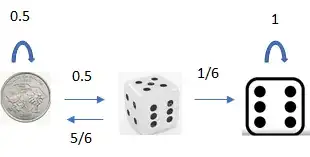Assume a coin and a six-sided die. At the first move, you flip a coin. If you get a heads, you get to roll the die. If you get a tails, you have to flip the coin again. When you roll the die, if you get a $6$, the game is over. If you don't get a $6$, you have to flip the coin again. What is the probability of getting a $6$ on the die within $6$ moves? Each coin flip or die roll is a move.
I tried it with $4$ moves using brute force method with a tree diagram, and found an answer of $4$ in $60$, or $1$ in $15$. What I want to know is the general solution of this game within $n$ moves.
